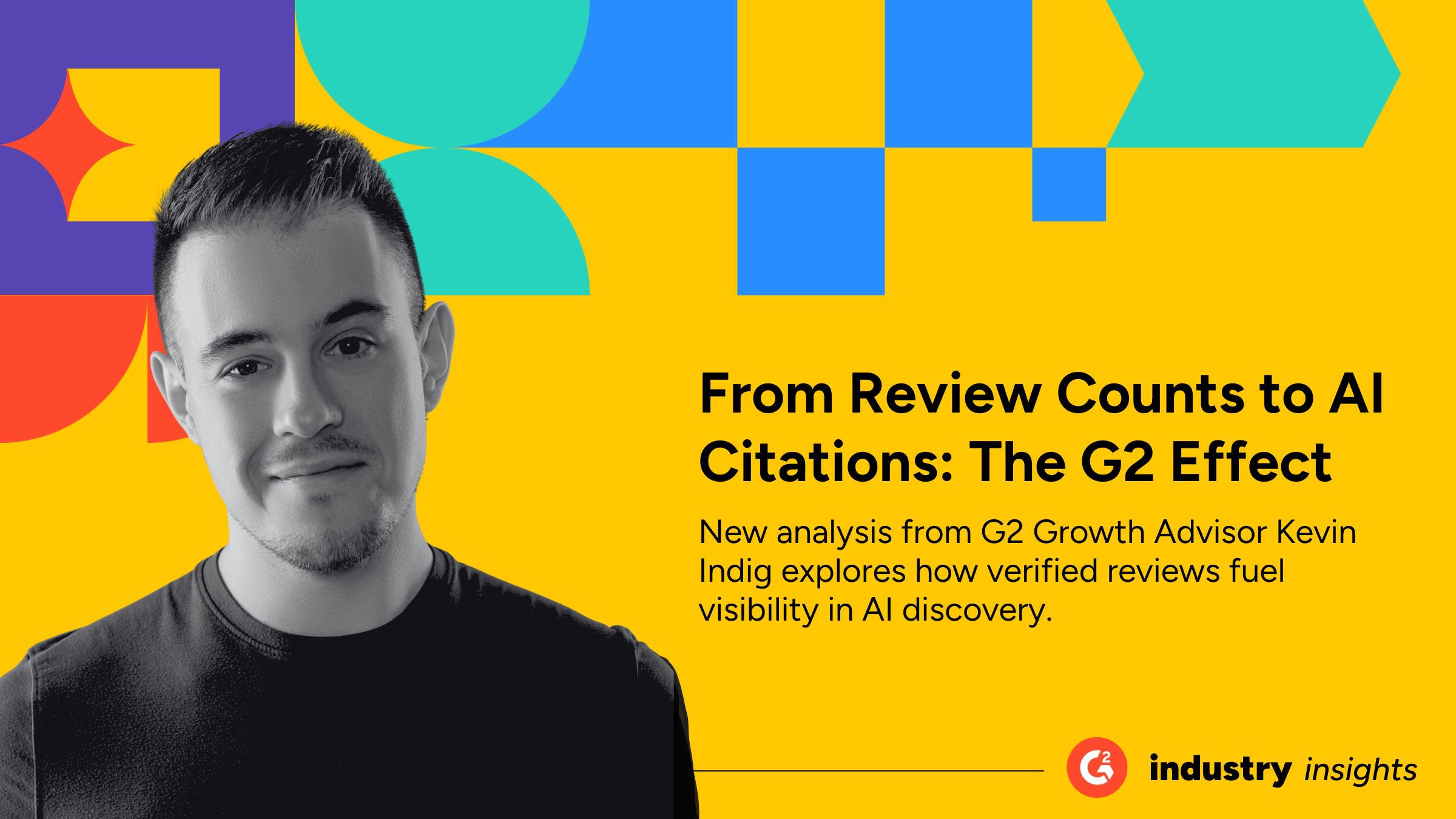October 23, 2025
.png?width=400&height=150&name=Kevin%20Indig%20headshot%20(2).png) by Kevin Indig / October 23, 2025
by Kevin Indig / October 23, 2025

AI visibility platforms, like Radix or Promptwatch, have found G2 to be the most cited software review platform.

Radix analyzed 10,000+ searches on ChatGPT, Perplexity, and Google’s AI Overviews and found G2 has “the highest influence for software-related queries” with 22.4%.
Additionally, PromptWatch found G2 to be the most visible B2B software review platform across 100 million+ clicks, citations, and mentions from AI search like ChatGPT, tracked across 3,000+ websites.
The data suggests that G2 has a meaningful impact on software searches on LLMs (e.g., ChatGPT, Perplexity, Gemini, Claude, etc.). As an independent researcher, I wanted to see if I could detect a relationship in our data and validate the claims.
To get there, I analyzed 30,000 AI citations and share of voice (SoV) from Profound, which span across 500 software categories on G2.
Categories with more G2 Reviews get more AI citations and a higher SoV. When ChatGPT, Perplexity, or Claude need to recommend software, they cite G2 among the first. Here’s what I found.
The data shows a small but reliable relationship between LLM citations and G2 software reviews (regression coefficient: 0.097, 95%, CI: 0.004 to 0.191, R-squared: 0.009).
Categories with 10% more reviews have 2% more citations. That's after removing outliers, controlling for category size, and using conservative statistical methods. The relationship is clean.

I also found a small but reliable relationship between G2 Reviews and SoV (regression coefficient: 0.113, 95% CI: 0.016 to 0.210, R-squared: 0.012).
If reviews rise by 10%, SoV increases by roughly 0.2-2.0%.

The number of citations and the SoV are primarily determined by factors outside this analysis: brand authority, content quality, model training data, organic search visibility, and cross-web mentions. Reviews explain less than 2% of the variance, which means they're a small piece of a larger puzzle.
But why G2 specifically?
AI models face a verification problem. They need scalable, structured signals to assess software quality. G2 provides three attributes that matter: verified buyers (reduces noise), standardized schema (machine-readable), and review velocity (current market activity). With more than 3 million verified reviews and the highest organic traffic in software categories, G2 offers signal density that other platforms can't match.
A 10% increase in reviews correlating with a 2% increase in citations sounds modest. But consider the baseline: most categories receive limited AI citations. A 2% lift on a low base may be practically negligible. However, in high-volume categories where hundreds of citations occur monthly, a 2% shift could meaningfully alter competitive positioning. In winner-take-most categories where the top three results capture disproportionate attention, small citation advantages compound.
What matters isn't your raw review count, but your position relative to competitors in your category. A category with 500 reviews where you hold 200 positions has a different impact than a category with 5,000 reviews where you hold 200.
The buying journey is transforming. In G2's August 2025 survey of 1,000+ B2B software buyers, 87% reported that AI chatbots are changing how they research products. Half now start their buying journey in an AI chatbot instead of Google — a 71% jump in just four months.
The real disruption is in shortlist creation. AI chat is now the top source buyers use to build software shortlists — ahead of review sites, vendor websites, and salespeople. They're one-shotting decisions that used to take hours. A prompt like "give me three CRM solutions for a hospital that work on iPads" instantly creates a shortlist.
When we asked buyers which sources they trust to research software solutions, AI chat ranked first. Above vendor websites. Above salespeople.
When a procurement director asks Claude to share the "best CRM for 50-person teams" today, they're getting a synthesized answer from sources the AI model trusts. G2 is one of those sources. The software industry treats G2 as a customer success box to check. The data suggests it's become a distribution channel — not the only one, but a measurable one.
The best way to apply the data is to invest in reviews and G2 Profiles:
To conduct this research, we used the following methodology and approach:
We took 500 random G2 categories and assessed:For the outcome, the median was unchanged, which supports that pruning did not bias the center of the distribution.
We analyzed the regression coefficient, 95% confidence interval, sample size, and R-squared.These limitations suggest our estimates should be interpreted as suggestive associations rather than causal effects. The relationship between reviews and AI citations is statistically detectable but operates within a complex system of multiple influence factors.
Kevin Indig is an advisor to some of the world’s fastest-growing startups and has defined Organic Growth strategies for companies like Ramp, Reddit, Bounce, Dropbox, Hims, Nextdoor, and Snapchat. Kevin led SEO and Growth at the world’s leading e-commerce platform Shopify, the #1 marketplace for software G2 and the #1 developer company Atlassian. Once a week, he sends The Growth Memo to 20k+ subscribers and regularly speaks at conferences around the world.
The world of AI search is moving fast, and this week’s news is all about Reddit and OpenAI. Or...
.png) by Kevin Indig
by Kevin Indig
We’ve been tracking the rise of AI search and predicting its impact on the tech landscape...
 by Kamaljeet Kalsi
by Kamaljeet Kalsi
Database administrators are more important than their title might reveal to the layman.
.png) by Kevin Indig
by Kevin Indig
The world of AI search is moving fast, and this week’s news is all about Reddit and OpenAI. Or...
.png) by Kevin Indig
by Kevin Indig
We’ve been tracking the rise of AI search and predicting its impact on the tech landscape...
 by Kamaljeet Kalsi
by Kamaljeet Kalsi


